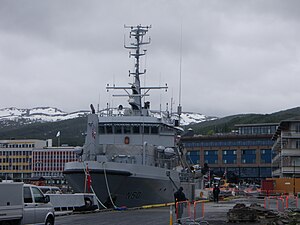HNoMS Tyr (N50)
 Tyr in Harstad in June 2011.
| |
| History | |
|---|---|
| Name | HNoMS Tyr |
| Namesake | Norse god Týr |
| Builder | , Fosnavåg (31) |
| Laid down | 23 January 1981 |
| Launched | 23 May 1981 |
| Completed | August 1981 |
| Commissioned | 7 March 1995 |
| Decommissioned | August 2014 |
| Identification |
|
| Fate | Sold to Idefix Danmark ApS, Hobro. Renamed IDEFIX |
| General characteristics | |
| Displacement | 735 tons full load |
| Length | 42.5 m (139.4 ft) |
| Beam | 10 m (32.8 ft) |
| Draught | 6.5 m (21.3 ft) |
| Ice class | 1A |
| Propulsion | Two x Deutch BA 12M816 |
| Speed | 18 knots (33.3 km/h) |
| Range | 17,000 nautical miles |
| Complement | 20 |
| Armament | M2HB MG |
| Notes | Pennant number N50 IMO Number |
HNoMS Tyr was a mine control vessel used for underwater search and recovery by the Royal Norwegian Navy. It was decommissioned in 2014 and sold to private owners.
History[]
Tyr was built at in 1981 and was used as an offshore standby-ship in the North Sea under the name MS Standby Master, yard number 31. The Royal Norwegian Navy took her over in December 1993, and Tyr went through a comprehensive rebuilding and modernization program between 1994 and February 1995 at the shipyard in Bergen. Under the rebuilding Tyr was equipped with new thrusters, the bridge was expanded and a mine hangar was built on the aft-deck, and new hydraulic equipment was installed on the work-deck. Tyr was fitted with tactical systems, and was equipped with a Scorpio ROV. The furnishings were also modernized.[citation needed]
In 2014, Tyr was put up for sale by the Norwegian Armed Forces, with an estimated price of 15-20 million kr.[1]
Sold to Idefix Danmark ApS, Hobro. Renamed IDEFIX, August 2014.[2]
Wreck discoveries and recoveries[]

HNoMS Tyr has discovered and/or recovered several wrecks:
- Localization and filming of the German battleship Scharnhorst in cooperation with the Norwegian Broadcasting Corporation.[3]
- Localization and filming of the German submarine U-864, sunk west of Fedje in 1945.[4]
- Localization and filming of the German submarine U-735, sunk near Horten in the Second World War.[3]
- Localization and filming of the Polish troop-transport ship Chrobry, sunk in the Vestfjorden in 1940.[3]
- Localization and filming of the Norwegian coastal express ship , sunk off Bodø on 23 October 1940.[5]
- Localization and filming of the Royal Navy destroyer Hunter sunk on 10 April 1940 during the Battles of Narvik[6]
- Localization of the German prisoner transport ship Palatia, sunk in the Second World War. This is the second largest ship disaster in Norwegian history.[3]
- Relocalization of the Norwegian submarine Uredd, sunk on 24 February 1943 after hitting a German minefield.[3]
- Localization and recovery of a Norwegian F-16 fighter jet, which had crashed in Bindalsfjorden, May 1997.[3]
- Localization and recovery of a Norwegian F-16 fighter jet, which had crashed in the sea off Landegode, Bodø.[7]
- Search localization of assumed deceased, after the Sleipner disaster.[3]
- Search and recovery of both helicopter and the deceased after a helicopter crashed in the Førdefjorden in October 1996.[3]
References[]
- ^ Emberland, Torkil (19 May 2014). "Den kan brukes til alt fra skattejakt til oljeleting, og kan bli din for 20 millioner". Nordlys (in Norwegian). Retrieved 21 May 2014.
- ^ "Working".
- ^ Jump up to: a b c d e f g h Official Norwegian Defence Force website: Over 5,000 graves found Archived 2004-01-07 at the Wayback Machine (in Norwegian)
- ^ Tor Leif Pedersen (27 February 2007). "- Tonnevis med kvikksølv ikke funnet". Bergens Tidende (in Norwegian). Retrieved 5 July 2011.
- ^ Lawson, Siri Holm. "D/S Prinsesse Ragnhild". Warsailors.com. Retrieved 7 July 2011.
- ^ "Sunken WWII ship found in fjord". BBC News. 5 March 2008. Retrieved 5 July 2011.
- ^ "Oppdaget ny koralldyrart utenfor Bodø". Dagbladet (in Norwegian). 3 May 2001. Retrieved 5 July 2011.
External links[]
| Wikimedia Commons has media related to IMO 8019409. |
- Video from HNoMS Tyr (in Norwegian)
- Another video from HNoMS Tyr (in Norwegian)
- 1981 ships
- Ships built in Norway
- Mine warfare vessels of the Royal Norwegian Navy